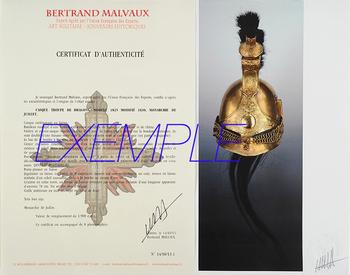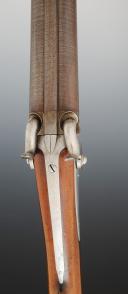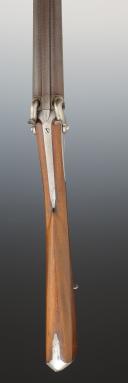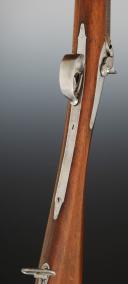
CORSE VOLTIGEUR RIFLE, first type, 1840 model, July Monarchy. 29923
CORSE VOLTIGEUR RIFLE, first type, 1840 model, July Monarchy. 29923
Rifle resembling double-barreled side-by-side hunting rifles, with faux damascus and blued finish, with twisted ribbons. Barrel length 81.2 cm, with breech 97.7 cm, caliber 18 mm. Unmarked locks bearing a crowned oval 'g' stamp, percussion locks, walnut stock with short forend widely separating the barrels. All fittings in steel. Steel ramrod. Tang welded to the right barrel, intended to attach a bayonet. The first model of the rifle does not have any markings, only the lock is stamped. This feature is due to the fact that it was manufactured in different workshops and then brought to the factory for assembly, distinguishing it from the following model which would be marked in the factory.
Overall length of the rifle 1.245 m.
France.
July Monarchy.
Near new condition.
HISTORICAL BACKGROUND - Excerpt from the Gazette des Armes, No. 48, April 1977, from the article by Robert Marquiset.
In 1837, Baron Desmichelt, military governor of Corsica, requested the Minister of War to study a double-barreled firearm more suitable for military operations in the maquis. Despite the numerical superiority and military value of the troops tasked with maintaining order in this turbulent department, the outlaws often had the upper hand. They used percussion double-barreled hunting rifles, a system still very modern at the time, against the flintlock firearms model 1822 carried by the law enforcement forces.
In his request, Baron Desmichelt expressed a number of wishes. The weapon should have long range and precision, a bayonet, be percussion-based, have a blued finish to eliminate reflections visible to the enemy, and be of war caliber. The Baron's wishes were fully met. The Artillery Committee, however, suggested using the 24 caliber for hunting, which they deemed more manageable and lighter. The two trial models were manufactured in this caliber before being sent to Bastia. One had a rifled barrel, the other a smoothbore barrel.
Tests favored the smoothbore barrel for short-range shooting in the maquis, as it was more suitable for combat conditions and easier to use. Notably, at the same time, during the conquest of Algeria, the rifled barrel was chosen. However, the situation there called for dealing with Arab gunmen armed with moukalas causing havoc at long distances.
On March 8, 1845, the Minister of War, recognizing the inadequacy of the musket in Corsica due to numerous bandits, ordered its replacement with a percussion double rifle.
Interesting to note that Corsican gendarmes, as well as those in western departments, kept their double rifles until 1870. At that time, they received the 1866 Winchester; however, this American firearm, proven in the Wild West, was deemed incompatible with the late 19th-century chauvinism, being too delicate, it was said. Subsequently, they were given the 1866-74 gendarme carbine. In 1877, 50 years after Baron Desmichelt's initiative, the cavalry command desired to return to the double-barreled rifle: as all Corsican bandits were armed with double-barreled guns, the minister wished the 20th legion gendarmes not to be outgunned by their adversaries.
CORSE VOLTIGEUR RIFLE
In May 1840, the minister approved the production of this rifle, stipulating the use of war caliber, i.e., 17.5 mm. The weapon thus used the standard cartridge, a 16.35 mm ball weighing 19 to the pound, with a 9-gram charge of musket powder.
The rifle was designed akin to a hunting rifle. In fact, all parts were crafted by artisans from the Saint-Étienne region and assembled in a factory. The barrel, like those of quality hunting arms, featured twisted steel ribbons soldered in pairs on a connecting band. In March 1842, it was decided to replace its civilian nipples with regulation nipples. Since Paris National Guard non-commissioned officers were to be armed with these rifles, it was strategically inconceivable for them not to use military caps.
Despite its unassuming military appearance, given its firepower advantage, the War Ministry briefly considered expanding its use throughout the army. However, the Artillery Committee strongly advised against it due to its excessive weight and caliber. The standard caliber had now become 18 mm while the double rifle's caliber was still 17.5 mm. Moreover, this gun's use by young recruits posed various risks: double loading in one barrel and delicate handling of the two triggers during disarming.
It was replaced by the double rifle, 1850 model.
PAYMENT INFORMATION:
Firearms cannot be paid for using PayPal as the company prohibits the trade of any type of firearms, including collectible firearms that are legal to own and possess. Therefore, only checks, remote credit card payments (VPC), and IBAN transfers are accepted.
Warning requested by Google's search service:
This antique firearm is for collection purposes only and cannot be used as it is deactivated. Current cartridges are not compatible with this non-functioning firearm. The law of March 6, 2012 classifies firearms into 4 categories and controls their acquisition and possession modes. Correct classification is crucial. Decree No. 2013-700 of July 30, 2013 specifies the list of firearms for each category. The firearm presented here falls under category D2, freely possessable, hence can be purchased without restrictions, since it is inactive.
Rifle resembling double-barreled side-by-side hunting rifles, with faux damascus and blued finish, with twisted ribbons. Barrel length 81.2 cm, with breech 97.7 cm, caliber 18 mm. Unmarked locks bearing a crowned oval 'g' stamp, percussion locks, walnut stock with short forend widely separating the barrels. All fittings in steel. Steel ramrod. Tang welded to the right barrel, intended to attach a bayonet. The first model of the rifle does not have any markings, only the lock is stamped. This feature is due to the fact that it was manufactured in different workshops and then brought to the factory for assembly, distinguishing it from the following model which would be marked in the factory.
Overall length of the rifle 1.245 m.
France.
July Monarchy.
Near new condition.
HISTORICAL BACKGROUND - Excerpt from the Gazette des Armes, No. 48, April 1977, from the article by Robert Marquiset.
In 1837, Baron Desmichelt, military governor of Corsica, requested the Minister of War to study a double-barreled firearm more suitable for military operations in the maquis. Despite the numerical superiority and military value of the troops tasked with maintaining order in this turbulent department, the outlaws often had the upper hand. They used percussion double-barreled hunting rifles, a system still very modern at the time, against the flintlock firearms model 1822 carried by the law enforcement forces.
In his request, Baron Desmichelt expressed a number of wishes. The weapon should have long range and precision, a bayonet, be percussion-based, have a blued finish to eliminate reflections visible to the enemy, and be of war caliber. The Baron's wishes were fully met. The Artillery Committee, however, suggested using the 24 caliber for hunting, which they deemed more manageable and lighter. The two trial models were manufactured in this caliber before being sent to Bastia. One had a rifled barrel, the other a smoothbore barrel.
Tests favored the smoothbore barrel for short-range shooting in the maquis, as it was more suitable for combat conditions and easier to use. Notably, at the same time, during the conquest of Algeria, the rifled barrel was chosen. However, the situation there called for dealing with Arab gunmen armed with moukalas causing havoc at long distances.
On March 8, 1845, the Minister of War, recognizing the inadequacy of the musket in Corsica due to numerous bandits, ordered its replacement with a percussion double rifle.
Interesting to note that Corsican gendarmes, as well as those in western departments, kept their double rifles until 1870. At that time, they received the 1866 Winchester; however, this American firearm, proven in the Wild West, was deemed incompatible with the late 19th-century chauvinism, being too delicate, it was said. Subsequently, they were given the 1866-74 gendarme carbine. In 1877, 50 years after Baron Desmichelt's initiative, the cavalry command desired to return to the double-barreled rifle: as all Corsican bandits were armed with double-barreled guns, the minister wished the 20th legion gendarmes not to be outgunned by their adversaries.
CORSE VOLTIGEUR RIFLE
In May 1840, the minister approved the production of this rifle, stipulating the use of war caliber, i.e., 17.5 mm. The weapon thus used the standard cartridge, a 16.35 mm ball weighing 19 to the pound, with a 9-gram charge of musket powder.
The rifle was designed akin to a hunting rifle. In fact, all parts were crafted by artisans from the Saint-Étienne region and assembled in a factory. The barrel, like those of quality hunting arms, featured twisted steel ribbons soldered in pairs on a connecting band. In March 1842, it was decided to replace its civilian nipples with regulation nipples. Since Paris National Guard non-commissioned officers were to be armed with these rifles, it was strategically inconceivable for them not to use military caps.
Despite its unassuming military appearance, given its firepower advantage, the War Ministry briefly considered expanding its use throughout the army. However, the Artillery Committee strongly advised against it due to its excessive weight and caliber. The standard caliber had now become 18 mm while the double rifle's caliber was still 17.5 mm. Moreover, this gun's use by young recruits posed various risks: double loading in one barrel and delicate handling of the two triggers during disarming.
It was replaced by the double rifle, 1850 model.
PAYMENT INFORMATION:
Firearms cannot be paid for using PayPal as the company prohibits the trade of any type of firearms, including collectible firearms that are legal to own and possess. Therefore, only checks, remote credit card payments (VPC), and IBAN transfers are accepted.
Warning requested by Google's search service:
This antique firearm is for collection purposes only and cannot be used as it is deactivated. Current cartridges are not compatible with this non-functioning firearm. The law of March 6, 2012 classifies firearms into 4 categories and controls their acquisition and possession modes. Correct classification is crucial. Decree No. 2013-700 of July 30, 2013 specifies the list of firearms for each category. The firearm presented here falls under category D2, freely possessable, hence can be purchased without restrictions, since it is inactive.
Price :
2 500,00 €
| Destination | Envoi recommandé | Envoi Recommandé + Express |
|---|---|---|
| Shipping France | 30,00 € | 100,00 € |
| Shipping Europe | 40,00 € | 200,00 € |
| Shipping world | 120,00 € | 350,00 € |
Insurance (1%) :
25,00 €
Reference :
29923

Next update Friday, november 14 at 13:30 PM
FOR ALL PURCHASES, PAYMENT IN MULTIPLE CHECKS POSSIBLE
bertrand.malvaux@wanadoo.fr 06 07 75 74 63
SHIPPING COSTS
Shipping costs are calculated only once per order for one or more items, all shipments are sent via registered mail, as this is the only way to have proof of dispatch and receipt.
For parcels whose value cannot be insured by the Post, shipments are entrusted to DHL or Fedex with real value insured, the service is of high quality but the cost is higher.
RETURN POLICY
Items can be returned within 8 days of receipt. They must be returned by registered mail at the sender's expense, in their original packaging, and in their original condition.
AUTHENTICITY
The selection of items offered on this site allows me to guarantee the authenticity of each piece described here, all items offered are guaranteed to be period and authentic, unless otherwise noted or restricted in the description.
An authenticity certificate of the item including the description published on the site, the period, the sale price, accompanied by one or more color photographs is automatically provided for any item priced over 130 euros. Below this price, each certificate is charged 5 euros.
Only items sold by me are subject to an authenticity certificate, I do not provide any expert reports for items sold by third parties (colleagues or collectors).
FOR ALL PURCHASES, PAYMENT IN MULTIPLE CHECKS POSSIBLE
bertrand.malvaux@wanadoo.fr 06 07 75 74 63
An authenticity certificate of the item including the description published on the site, the period, the sale price, accompanied by one or more color photographs is automatically provided for any item priced over 130 euros. Below this price, each certificate is charged 5 euros.
Only items sold by me are subject to an authenticity certificate, I do not provide any expert reports for items sold by third parties (colleagues or collectors).









